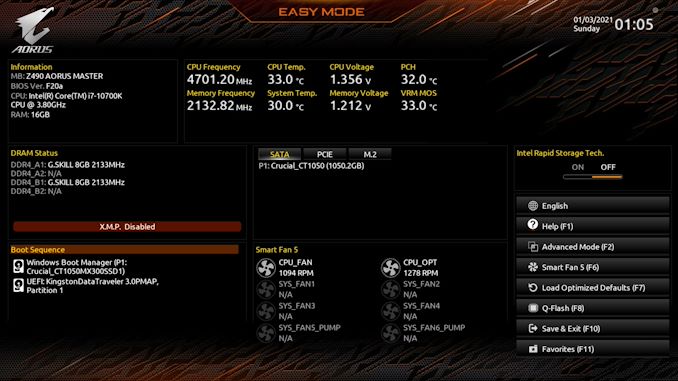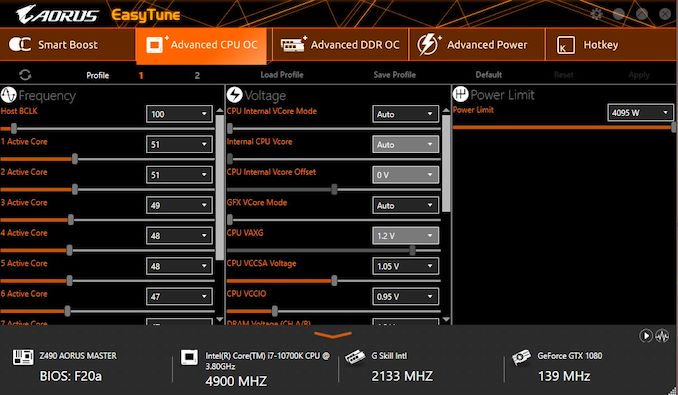GIGABYTE Z490 Aorus Master Motherboard Review: Clawing at the Competition
by Gavin Bonshor on January 7, 2021 8:00 AM EST- Posted in
- Motherboards
- Intel
- Gigabyte
- ATX
- AORUS
- Z490
- Comet Lake
- LGA1200
- Z490 Aorus Master
BIOS
The majority of the following analysis comes from our GIGABYTE Z490I Aorus Ultra review due to its use of virtually identical firmware and software package.
The firmware on the GIGABYTE Z490 Aorus Master uses a black and orange contrasting theme, with white text and dark orange highlights. The firmware itself has two primary modes, Easy mode and the advanced mode which users can access by pressing the F2 key.
When entering the firmware for the first time, the Easy Mode displays an essential list of information, including the version of the firmware being used, the installed processor, and information related to the CPU frequency, temperatures, and core voltages. To the bottom left-hand corner, users can change the boot sequence order, while the right-hand side displays a list of menus that can be accessed by pressing the corresponding key. Users can also access the Smart Fan utility by pressing the F7 key and putting the board into Q-Flash mode by pressing F8, which allows users to flash the board's firmware.
In the advanced mode, users can tweak and perform overclocks on both the CPU and memory and access more intricate parts, including the chipset related options. There's plenty of options for users to get to grips with, including an extensive list of CPU and memory frequency, memory latency, and voltage settings. Other options included within the firmware also stretch to integrated graphics frequency and settings for changing the ring and base-clock frequencies. For enthusiasts, GIGABYTE includes power-related options for Intel's VF Curve and power profiles, as well as settings to change the power delivery and load-line calibration settings for tighter or slacker VDroop control.
The GIGABYTE Aorus firmware in itself is easy to navigate and use, although as we found in our Z490I Aorus Ultra review, the options in each menu are very tightly packed and crammed in. Despite this, GIGABYTE lists most of its core options in long lists, so it's not too difficult for users to find the options they are looking for. The firmware itself is responsive and relatively easy to navigate.
Software
All of GIGABYTE's software package revolves around the Aorus App Center, which acts as a central hub for all of its core software. It also provides access to a wide variety of Windows-related settings from the control panel, including power options, network settings, and direct access to Windows integrated Firewall.
The most useful of GIGABYTE's software bundle is the EasyTune software, which allows users to overclock within Windows. It includes a wide variety of customizable options, including settings to overclock the CPU on a per-core basis in 100 MHz increments or sync all-cores for more hardened and heat-intensive overclocks. There are also options to change the memory frequency on the fly and DDR4 primary latency timings. It also provides CPU VCore current protection options and GIGABYTE's Loadline Calibration settings for users looking to overclock further than Intel's Turbo does.
Other useful applications include GIGABYTE's Fusion 2.0 RGB software, which allows users to control the integrated LED lighting and RGB LED strips plugged into the board's headers. The System Information Viewer (SIV) allows users the ability to see a list of components installed into the system, including specifications such as core and thread count, as well as access to the Smart Fan 5 cooling utility. GIGABYTE includes its own Realtek Audio Control Panel software and allows users to update the board's firmware within Windows using the @BIOS software.

























17 Comments
View All Comments
Deicidium369 - Thursday, January 7, 2021 - link
They do CPU testing - did someone take them and sell them on Ebay?Ian Cutress - Friday, January 8, 2021 - link
We don't all work in a singular office. Ryan and I are several thousand miles away. We started the Intel 400-series testing with the 8 core and it's continued through.anomalydesign - Friday, January 8, 2021 - link
I'm surprised to see this review now with Z590 coming out in less than a week (and Gigabyte leaking their own Aorus lineup today, in fact).I guess it could still be a useful board to try and find on clearance for Rocket Lake (z590 doesn't seem to offer anything that you can't find on Z490, as far as I can tell), but testing a board of this level with a mid-tier CPU seems kind of crazy to me. I was wondering why the numbers looked so off until I realized I'd overlooked the 10700k in the testing notes. Very odd choice, for VRM analysis.
fogifds - Monday, January 11, 2021 - link
Shouldn't I wait for Z590?Tom Sunday - Friday, January 29, 2021 - link
It does make sense to wait until the new Z590 boards hit the deck. Making sure that there are extra worth while boxes to be checked and seen and before making any $$$ jump. But we already know to get ready for sticker shock. Looked at the Z590 ASUS HERO VIII and this baby checks out at a cool $500. While BH has the Z490 Hero at around $379. If I only had the cash...but you know that drill.rubi - Tuesday, January 12, 2021 - link
wonder to see your stuff, i learned a lot of new things.https://odindownloads.net
NDRE28 - Monday, March 8, 2021 - link
Yeah.Gigabyte is a very serious vendor.
I own a Gigabyte Z390 Aorus Master, and it runs flawlessly.
I also had other Gigabyte motherboards (non-Aorus) in the past and they all worked well.